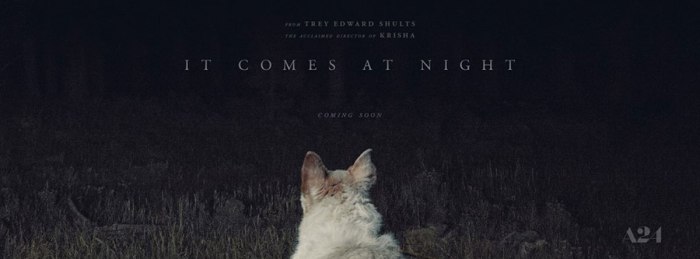
The modern horror genre often does not leave much up to the imagination when it comes to stirring up fear in its viewers. Whether it be a crazed killer with a machete, a grotesque demonic figure, or a flesh-craving alien, most pop-horror films leave you only a short amount of time until you can see in vivid detail what is wrong and who or what is committing that wrong. Unlike most of these films, Trey Edward Shults’ “It Comes at Night” leaves almost everything up to the imagination, and it is every bit as terrifying as most pop-horror films without relying on jump-scares to rattle its audience.
The film takes place in a post-apocalyptic world with a disease which is left intentionally vague besides a few details: it is spread through touch and it comes at night. The opening sequences involve the main protagonists—a husband and wife and their son—preparing to euthanize the plagued grandfather of their family. We are told there are probably only a handful of people left in the world, and that those remaining have turned violent and desperate for survival. This family does not take any extra risks of their own survival as evidenced by there only being one way in and out of their carefully boarded-up home. It’s not long before there’s a bump in the night, and something is found lurking in their house. It turns out to be a reasonable and likable man trying to find water for his family. The intruder tells them that his family is 50 miles away and in desperate need of food and water, but something still seems off. Something always seems off in this film—just *off* enough to get under your skin.
From the very beginning til the very end of the film, the fear of the unknown is at the center. There are no ghosts or demons to buffer this fundamentally human fear instead we are left to experience each aching moment of paranoia that these protagonists must deal with in their frightening world.
Many techniques are utilized throughout the film to help produce an atmosphere just haunting enough to leave you emotionally shaken and deeply confused: eerie lighting, visual illusions, maddening dream sequences, oddly-paced dialogue, and claustrophobic, alternating aspect ratios . This is not your normal pop-horror film. You do not get jump-scares—you get dread. You do not get a wholly evil villain—you get people like yourself. You do not get a disturbing answer as much as you get a horrifying silence.
This fear of the unknown is everywhere in this film and in so much of our world today: in strangers, in the dark, in the disease, and in death. There is a real threat though, and it is not a film that pretends there is an easy solution. Distrust, fear, anxiety, and paranoia are understandable responses to the worlds in which we and these protagonists live, but this horror film does not let you naively assume that “survival of the fittest” is an easy pill to swallow. Instead it makes you slowly choke on it. You can board up your house and live in defensive isolation hoping for the extinction of everyone else, but what happens when those inside start to show signs of not only an external disease but of an internal and even more heinous disease?
Self-preservation may get you an extra day or month or year in a diseased world, but it is hard to imagine a life without hospitality, trust, vulnerability, or friendship—however costly these things may be. Is it the length or quality of our lives that matter? “It Comes at Night” simultaneously rejects a sentimental altruism or a glorified egoism. Each character’s decisions come at the expense of their physical life or their own soul. Hospitality may bring a disease inside your home, but Xenophobia may reveal an even more serious disease emerging from within your own house.
There is very little redemption within the universe of this film. In a diseased world, everything dies, and that darkness is coming for each and every one of us. Thankfully from a Christian perspective, the disease doesn’t have the final say. The words of Jesus from the Gospel of Matthew have been ringing in my head since I watched the film’s sober ending, “For whoever would save his life will lose it, but whoever loses his life for my sake will find it.” I realize this must bear eternity in mind with the temporal, yet this film has no sense of eternity or afterlife. All that is is what will be and nothing else. Bodies are burned, and no funerals are given. Death is the end of all things in this film, and it’s everywhere. Without a promise of a resurrection or a world fully restored in the life to come, open doors, open tables, or even open hearts are a risk many may deem not worthy of being taken in light of death’s creeping imminence.
This film doesn’t pull any punches in revealing the deep fear and anxiety many of us have in making the most of our fragile, little lives especially as it is expressed through humanity’s neurotic control-issues and distrust of the unknown. But in turning in on ourselves and turning toward our own individual survival, we see that these characters are perhaps just as sick as those outside their house despite having much more than most in their world. Ironically, in pursuit of a full life, they had been losing theirs all along.
“It Comes at Night” is a despairing film but uses that despair to tell us something. Its observations on humanity, survival, and inhospitality hit deeply. And seems to pound its audience with a question repeatedly from beginning til end and even on the car ride home:
Is avoiding what is in the darkness for more life and less love better than embracing what is in the darkness for more love and less life?